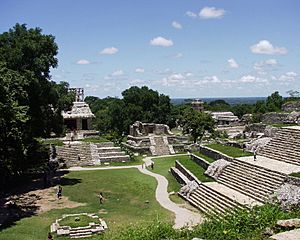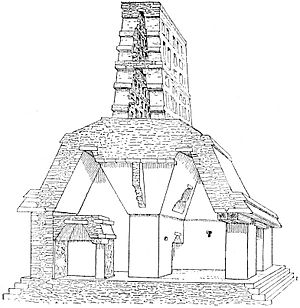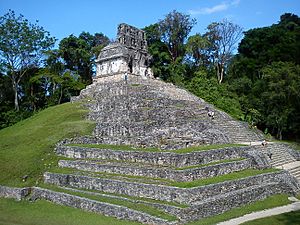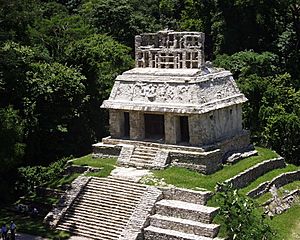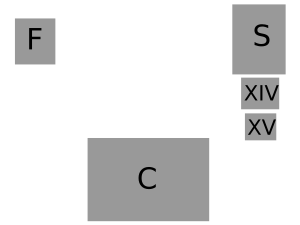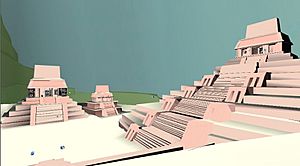Temple of the Cross Complex facts for kids
The Temple of the Cross Complex is a group of ancient temples at the Palenque site. Palenque was a major city of the Maya people. This complex is found in the state of Chiapas, Mexico. It has three main buildings: the Temple of the Cross, the Temple of the Sun, and the Temple of the Foliated Cross. The Temple of the Cross is the biggest and most important one.
These temples are step pyramids with special carvings called bas-reliefs inside. The Temple of the Cross was built to celebrate Chan Bahlum II becoming king. This happened after his father, Pacal the Great, passed away. The carvings show Chan Bahlum receiving a gift from his father. The "cross" shape in the temples actually represents the World Tree. This tree is central to Mayan stories about the world.
History of the Cross Complex
The Temple of the Cross complex was built by Kan-Bahlum. He was a ruler who reigned from 684 AD to 702 AD. One main reason for building these temples was to keep records. They held stone panels that told the story of Kan-Bahlum's family. They also explained how he became king and how his family line was special.
Inside the temples, there are carved stone tablets. Each tower has one tablet. These tablets have hieroglyphic writing. This writing explains what each temple was for. They also tell about the three main gods of Palenque. These gods are known as GI, GII, and GIII. The tablets explain their right to lead.
The pyramids in the Cross Complex were built a long time ago. This was during the Late Classic period of Mesoamerican chronology. They followed the usual building styles of the time. They used detailed carved stone to create their amazing stepped design. These three temples are special. They are the only buildings in the Maya world that act like a three-part book. This "book" is like a bark paper book. Inside the temples, you can find real history and stories from Maya mythology. The history makes sense as you move from one temple to the next. It's like reading a story.
Archaeologists have found proof that the Palenque site was attacked. This happened in 599 and 611 by a city called Calakmul. These attacks might have inspired the kings to build more. Pacal started this building tradition. His son, K'inich Kan Bahlam, and grandson, Akul Mo' Naab, continued it. After another attack by Toniná around 800, building stopped. The number of people living at the site also went down.
When the Spanish arrived in the 1500s, Palenque was empty. The Maya people in the area had forgotten about it. In 1567, a man named Father Pedro Lorenzo de la Nada was the first European to study the ruins. He wrote about them and named the site Palenque. He found the stone temples and plazas while exploring near the Usumacinta River.
Work to dig up, care for, and fix the Cross Complex started much later, in 1940. More money for upkeep came after a Mexican archaeologist, Alberto Ruz Lhuillier, made a big discovery. In 1952, he found the burial tomb of Pacal the Great. This was in the Temple of Inscriptions. Since then, Palenque has become one of the most studied ancient sites in the Americas. Archaeologist Jorge Acosta worked on the Cross Complex from 1967 to 1974. The Palenque Project began in 1989. It was led by archaeologist Arnoldo González Cruz. This project started many research and restoration efforts. In 1993, archaeologists found a special offering. It had over 100 incense burners inside the Temple of the Cross.
Temple Structure and Layout
The Cross Complex is at the bottom of a mountain. This mountain is called Yehmal K'uk' Lakam Witz. Its name means "The Great Mountain of the Descending Quetzal." The Maya people thought this mountain was holy. This is because many natural springs flow from it. These springs provide fresh water to the Otulum River. The Otulum River was the main water source for the city.
The buildings in the Cross Complex are made from limestone. This type of stone is easy to find in the area. Records from the 1500s say that the stone temples were covered in stucco. They were also decorated with blue and red paint. The three main temples in the complex are lined up to form a cross shape.
The Temple of the Foliated Cross is right across a courtyard from the Temple of the Sun. Both of these are next to the Temple of the Cross. There are also two smaller temples, Temple XIV and Temple XV. These are found between the Temple of the Sun and the Temple of the Cross. The picture on the left shows what the area might have looked like. It is seen from the Temple of the Foliated Cross. Temple XV is not shown in this drawing.
Bas-relief Carvings
The bas-relief carvings in the Temple of the Cross tell a story. They describe how K'inich Kan Balam became the ruler of Palenque. Inside the temples, there are carvings showing two figures. At first, experts thought the smaller figure was K'inich Janaab' Pakal, Kan Bahlum's father. They thought the bigger figure was Kan Bahlum himself.
Now, with more knowledge about ancient pictures and writing, it's believed both figures are Kan Bahlum. One shows him as a young person during a special ceremony. The other shows him as an adult, becoming king. Between these two figures is the Ceiba tree. This tree is also known as the World Tree.
Each of the three temples is also linked to one of the Palenque triad gods. These temples represent paths to the Otherworld. These paths were very important for the king. He had to take them to bring back gifts of life and good fortune for his people. The most important temple in this group is the Temple of the Cross. It is connected to God GI. He is the first-born god in the triad. He is also known as Hunahpu. He looks like a human but has special features. He has a shell earring, a square eye, and a fish fin on his cheek. He often wears a special monster headdress. He is also linked to a "Waterbird." It's important to remember that Kan-bahlum lived and ruled before these triad gods. He built these temples so the gods could leave their mark on them.


